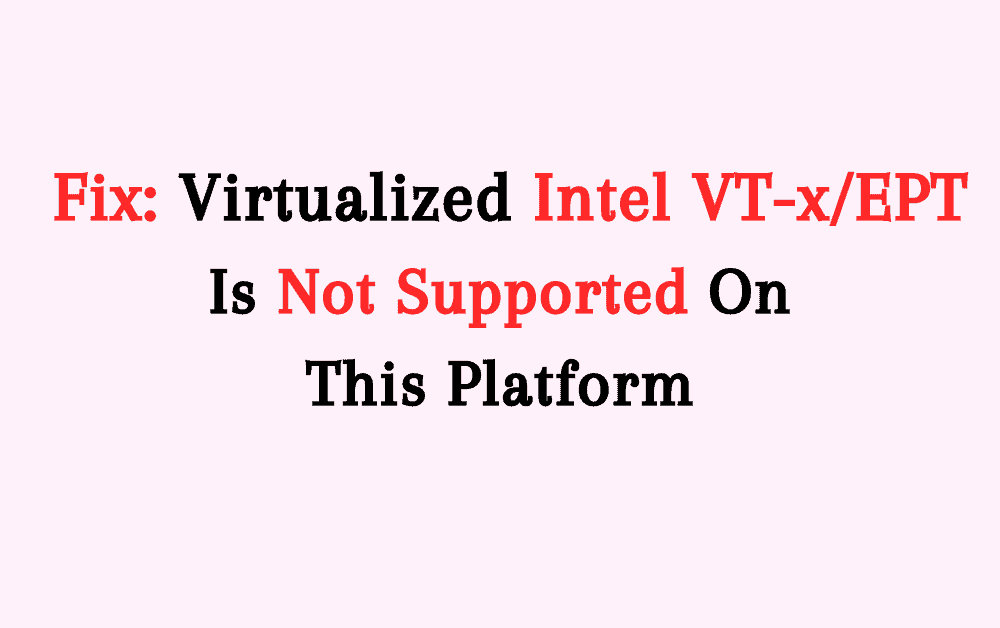Are you encountering the frustrating “Virtualized Intel VT-x/EPT is not supported on this platform” error?
If so, you’re not alone.
Many users have faced this issue when trying to run virtual machines on their systems.
Fortunately, there are several effective solutions to this problem.
In this blog, we’ll explore the practical steps to fix it, ensuring that you can smoothly run your virtualized environments without any hindrances.
How To Fix Virtualized Intel VT-x/EPT Is Not Supported On This Platform

To fix virtualized intel VT-x/EPT is not supported on this platform you can check BIOS settings, update BIOS firmware, run command to disable hypervisor. Additionally, you can check windows features, disable hyper-v using command prompt, check third-party software, update virtualization software, and ensure hardware compatibility.
1. Check BIOS Settings
This step is crucial as it allows the system to fully utilize hardware-assisted virtualization, resolving the error related to unsupported virtualization.
To check BIOS settings:
- Restart your computer and access the BIOS settings by pressing the designated key (often F2, F10, F12, or Del) during the boot process.
- Look for the virtualization settings, which may be labeled as “Intel Virtualization Technology” or “Intel VT-x” for Intel processors. For AMD processors, it may be labeled as “AMD-V”.
- Ensure that virtualization support is enabled. If it’s disabled, make the necessary changes and save the settings before exiting the BIOS.
2. Update BIOS Firmware
Updating the BIOS firmware may address virtualization issues and provide improved compatibility, including enabling VT-x/EPT support.
To update BIOS Firmware:
- Visit the manufacturer’s official website to check for BIOS updates for your specific computer model.
- If an update is available, carefully follow the instructions provided by the manufacturer to download and install the latest BIOS firmware. This update may address virtualization issues and provide improved compatibility.
3. Run Command To Disable Hypervisor
- Open Command Prompt as an administrator by right-clicking on the Start button and selecting “Command Prompt (Admin)”.
- Enter the command
bcdedit /set hypervisorlaunchtype offand press Enter. - Restart your computer to implement the changes.
Executing this command is important as it disables the hypervisor, which can conflict with other virtualization software and hinder the proper functioning of VT-x/EPT.
4. Check Windows Features
Ensure that “Hyper-V” is unchecked in the Windows Features window, as Hyper-V can conflict with other virtualization software and prevent proper utilization of VT-x/EPT. To do this,
- Press the Windows key + R, type “optionalfeatures” in the Run dialog, and press Enter to open the Windows Features window.
- Look for “Hyper-V” and ensure that it’s unchecked. If it’s currently enabled, disabling it may resolve the virtualization error.
5. Disable Hyper-V Using Command Prompt
Disabling Hyper-V using the command prompt is important as it can conflict with other virtualization software and hinder the proper functioning of VT-x/EPT.
- Open Command Prompt as an administrator by right-clicking on the Start button and selecting “Command Prompt (Admin)”.
- Type the command
bcdedit /set hypervisorlaunchtype offand press Enter. - Restart your computer to apply the changes.
6. Check Third-Party Software
Certain third-party applications or security software can interfere with virtualization. Temporarily disable or uninstall such software to see if it resolves the issue.
7. Update Virtualization Software
If you’re using virtualization software such as VMware or VirtualBox, ensure that you have the latest version installed.
Check for updates and install them if available, as newer versions may address compatibility issues.
8. Ensure Hardware Compatibility
Verify that your hardware supports virtualization. Some older processors may lack virtualization support, which can result in this error.
If your processor lacks virtualization support, consider upgrading to a compatible processor to enable VT-x/EPT functionality.

